
AMS travels to Turkey to talk with the plant directors of Tofas and Honda Turkiye to uncover what it takes to run a successful automotive production facility in this ever-changing market
In March this year, the Turkish government introduced a package of temporary tax cuts designed to stimulate the flagging local economy. As part of this, the private consumption tax rate (OTV) on new cars with engines smaller than 1.6 litres was reduced from 37 to 18%. Vehicles with an engine capacity between 1.6 and 2.0 litres had the tax rate reduced from 60 to 40%.
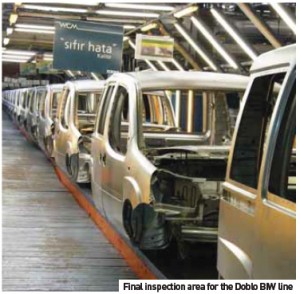 Put in place for only 90 days, the tax cuts tempted buyers back into the market, but the overall effect proved to be a mixed bag for local carmakers. On the one hand, larger companies were able to clear a sizeable portion of their standing inventories. For those manufacturers with only a small amount of finished vehicle stock, the tax cuts were an opportunity missed – though through no fault of their own. Ísmail Sümer, Executive Factory Manager at Honda Turkiye, says that the carmaker was unable to meet the sudden increase in demand. “The recent downturn was not so bad for us, we didn’t have too much stock. The tax incentive was only for a short period of time. We have an extended lead time in regards to part delivery. Parts coming from Japan are ordered three months in advance, our suppliers need to make, pack and ship parts, so we couldn’t immediately respond to the demand.” Sümer explains that the solution to this problem would be to further increase local content ratio of the Civic saloon models produced at his facility, the total amount currently standing at 41%. “For us ‘local’ simply excludes all CKD parts delivered from Japan. All other parts are considered local. If we get items from the US, Europe or Turkey, it’s all local. We buy from the location that is the cheapest and still meets Honda standards.”
Put in place for only 90 days, the tax cuts tempted buyers back into the market, but the overall effect proved to be a mixed bag for local carmakers. On the one hand, larger companies were able to clear a sizeable portion of their standing inventories. For those manufacturers with only a small amount of finished vehicle stock, the tax cuts were an opportunity missed – though through no fault of their own. Ísmail Sümer, Executive Factory Manager at Honda Turkiye, says that the carmaker was unable to meet the sudden increase in demand. “The recent downturn was not so bad for us, we didn’t have too much stock. The tax incentive was only for a short period of time. We have an extended lead time in regards to part delivery. Parts coming from Japan are ordered three months in advance, our suppliers need to make, pack and ship parts, so we couldn’t immediately respond to the demand.” Sümer explains that the solution to this problem would be to further increase local content ratio of the Civic saloon models produced at his facility, the total amount currently standing at 41%. “For us ‘local’ simply excludes all CKD parts delivered from Japan. All other parts are considered local. If we get items from the US, Europe or Turkey, it’s all local. We buy from the location that is the cheapest and still meets Honda standards.”
Yet while increasing Turkish-sourced content would substantially reduce delivery lead times, becoming an approved Honda supplier is a time-consuming process. According to Sümer, parts from a new supplier are subjected to a series of extended endurance tests by Honda in Japan, a process that can take between six and eight months. Only once the parts have been approved can orders be placed with that local supplier. “Approval is given based on quality,” he underlines.
Sümer goes on to say that the Turkish suppliers currently delivering parts to Honda Turkiye are largely based in Bursa, a two-hour drive from the plant. This, he observes, reduces transportation costs and promotes simplified delivery and quality management. Parts made in Bursa include bumpers, delivered unfinished and painted at the Honda facility, and also completed seats. “Some parts for the seats are delivered from Japan, but our local supplier assembles those parts with the local part content to deliver completed units. Also, Bridgestone has a plant in Turkey. They deliver to us, having already been tested by Honda.”
With a three-month lead time for Japanese-delivered parts, it could appear that the Honda Turkiye plant would have a 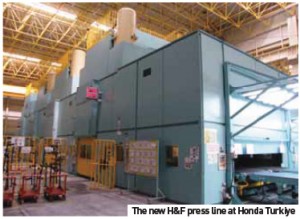 sufficient parts to supply a sudden increase in market demand. Not so, though, as the plant receives weekly shipments to supplement its inventory. Sümer: “Based on the shipping schedule, we have about 10 days of CKD stock from Japan. For some local suppliers, we only have one or two days of stock. Of course, for smaller parts, we may have many days of stock, just because it takes up very little space.” The current Japanese-delivered vehicle part content of 59% was considerably higher before Honda Turkiye installed a new H&F press line. Started in December 2008, the transfer presses produce 22 large panel parts for the Civic, including the side panels and roof. “Once we increased our production capacity to 50,000upa, it became feasible to install a press shop here,” says Ísmail Sümer. “Before (the press shop), all body parts were shipped in from Japan or Thailand.”
sufficient parts to supply a sudden increase in market demand. Not so, though, as the plant receives weekly shipments to supplement its inventory. Sümer: “Based on the shipping schedule, we have about 10 days of CKD stock from Japan. For some local suppliers, we only have one or two days of stock. Of course, for smaller parts, we may have many days of stock, just because it takes up very little space.” The current Japanese-delivered vehicle part content of 59% was considerably higher before Honda Turkiye installed a new H&F press line. Started in December 2008, the transfer presses produce 22 large panel parts for the Civic, including the side panels and roof. “Once we increased our production capacity to 50,000upa, it became feasible to install a press shop here,” says Ísmail Sümer. “Before (the press shop), all body parts were shipped in from Japan or Thailand.”
The $30m addition does not as yet feature a blanking line; pre-cut sheets are delivered by steel supplier ArcelorMittal. Tooling dies for the press shop are delivered from Honda Engineering in Japan. Was Honda aware that in Bursa, Tofas had its own tooling division, supplying die sets to its own press shop and to OEMs including Alfa Romeo, Renault and Land Rover? “I know Tofas prepares dies,” says Sümer, “but Honda is well known for being able to internally supply any equipment related to automotive production!”
Tofas numbers
Türk Otomobíl Fabríkasi As, or Tofas as it is better known (pronounced Toe-fash), is a joint-venture between the Fiat Group and Koç Group, with each holding a 38% share of the carmaker. The company produces cars under the Fiat brand, and also for Peugeot and Citroën. There are currently six models in production, including the Doblo and New Doblo (the former to be phased out by the end of this year) and Fiorino – internally known as the Mini Cargo Van (MCV) – which is also the basis for the Peugeot Bipper and Citroën Nemo. Additionally, the plant also produces the Linea, Albea and Palio passenger cars.
Akim Aydemír, Industrial Operations Director, runs through the model production breakdown. “Currently we are manufacturing 1,100 cars per day. Of that, 600 are MCV. About 60% of this, about 350 units, goes to Peugeot and Citroën, the remainder to Fiorino. Of the remaining 500, 350 is Doblo and the other 150 is made up of passenger cars.” The Linea and MCV are based on the same platform, so these models are made on the same line. Doblo versions have their own line, while the Palio and Albea have a dedicated line, set up for very low production. The Tofas facility in Bursa comprises 900,000m2, 350,000m2 of which is covered. The plant has approximately 5,000 employees. According to Aydemír, the facility has a maximum capacity of 400,000upa. That said, this year the plant will produce almost 300,000 units, a new record. “Our maximum capacity is based on the capacity of our two paintshops. Currently we are working two shifts, six days per week. Three shifts would see us reach 400,000.”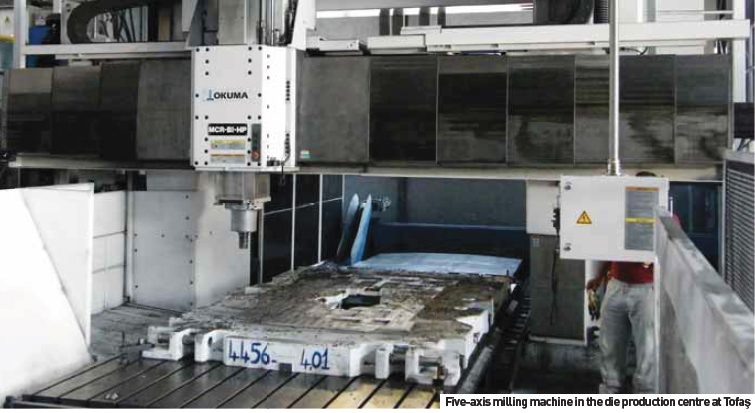
Aydemír goes on to say that his plant features all aspects of car production. This includes a stamping plant with a blanking press from Komatsu and transfer presses from Schuler and Aida, carrying on to weld, paint and assembly, which incorporates a separate area for suspension and axle kitting, a process feature unique amongst Fiat facilities. “We also have an R&D centre, ranked second in the Fiat Group and first in Turkey. This facility has the capability to design and produce a completely new model.”
Dedicated tooling production
A further part of this all-in-one facility is the die design and production area. “We make all our own dies here, it’s a state-of-the-art facility,” says Akim Aydemír. “Since we don’t change models very frequently, we also design and produce die sets for other carmakers.” Erkan Polat, Die & Press Shop Manager, reveals more about how dies are manufactured at Tofas. “We started as a die maintenance team, but over the last 10 years we have invested in the engineering and manufacturing of dies. Now we have 40 engineers and 180 workers making tools within the department.”
 Polat says the first step in making a die set is to receive the out-sourced castings. These are formed following blue prints of the new or updated vehicle design. “We always try and work together with the customer’s R&D department from the very early stages of a new model. This ensures the formability and manufacturability of the car in relation to the dies and panels. Based on this, we design two tool sets, with alterations made based on changes to the product, the look or the function of the sheet metal.” He adds that tooling changes can also be made to improve part finish and the amount of sheet metal required. After testing has been completed on the department’s ex-production press line, the dies are ready to enter series production.
Polat says the first step in making a die set is to receive the out-sourced castings. These are formed following blue prints of the new or updated vehicle design. “We always try and work together with the customer’s R&D department from the very early stages of a new model. This ensures the formability and manufacturability of the car in relation to the dies and panels. Based on this, we design two tool sets, with alterations made based on changes to the product, the look or the function of the sheet metal.” He adds that tooling changes can also be made to improve part finish and the amount of sheet metal required. After testing has been completed on the department’s ex-production press line, the dies are ready to enter series production.
At any given time the shop has a variety of projects underway. At time of visit, tooling is being developed for the new Fiat Panda, due to enter production at the company’s plant in Pomigliano, Italy. Continuing around the facility, Polat points at another die. “This is for a Mercedes model, but we’re not building directly for Mercedes, these are for a supplier. We’re helping them to try out the dies.” Raw castings are shaped using oversized five-axis machining centres, a movement range that allows the machining head to remain perpendicular to the material surface. The casts are designed to incorporate additional material, leaving room for final finishing. “The precision of the casting is not perfect, you cannot achieve the net shape with just the basic cast. In addition to the raw metal, there’s up to 10mm of additional material on the surface, a brittle, oxidized crust. We need to remove this in the finishing process to get to the pure metal underneath. That is where the strength is.”
The process that gauges how much material to remove from a die’s tooling surface is based on images taken using an Optigo 3D camera from Hexagon Metrology, the resulting CAD data and sample parts used to reverseengineer the dies. In the later stages of development, engineers compare these and other images with the original blue prints; the images are colour-coded to highlight where there are deviations within the die and where changes must be made. “It saves a lot of time,” says Polat. “We used to make actual dies for testing, but not any more. Using this technology, the whole die doesn’t need to be examined to see where changes are needed. Accuracy is improved and overall testing time is reduced.”
With regards to development and testing, Polat says that there has been a considerable reduction in the time required to deliver a completed die set. “The dies used to take 18 months to prepare, that’s now down to about six months.” With a tool set for a new model representing an average investment of €50m, longevity is crucial. Polat highlights what can be done to preserve the final product. “If we are forming an external shape we usually use chrome plating, but it depends on the part and also the company we are supplying. We prefer to coat the draw dies, while the others are heat-treated; they are very strong. It largely depends on the material being shaped, whether it is resistant or not. Cleaning the dies can also affect production efficiencies, chrome plating can make this easier.”
Polat adds that good maintenance is the key to die longevity. “Ten years ago, we made the die sets for the existing Doblo. We will soon be celebrating production of 1 million cars with the same dies. If they are maintained well, dies can last indefinitely.” Yet while it might be tempting to over-engineer tool sets in order to guarantee an extended lifespan, it does not pay to make them overly hard wearing. “Companies should invest exactly the amount needed to develop dies for a given production run. There is no need to make a very hard-wearing die set for a low production model.”
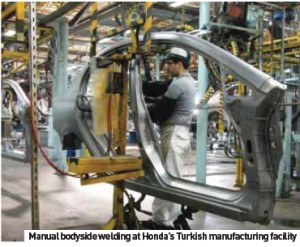 Compared with most Western car plants, both the Honda and Tofas plants feature comparatively few robots. In the case of Tofas, the weld shop features virtually all the plant’s automated activities, although the automation percentage is steadily increasing. Sinan Yildirim, Production Technology Manager, says for older models, 25% of all BIW processes were automated. For the out-going Doblo that increased to 45%, while 65% of all BIW processes for the New Doblo are completed automatically.
Compared with most Western car plants, both the Honda and Tofas plants feature comparatively few robots. In the case of Tofas, the weld shop features virtually all the plant’s automated activities, although the automation percentage is steadily increasing. Sinan Yildirim, Production Technology Manager, says for older models, 25% of all BIW processes were automated. For the out-going Doblo that increased to 45%, while 65% of all BIW processes for the New Doblo are completed automatically.Despite the increase, the weld shop does not have large areas dedicated to automation. Instead, robots are used in combination with manual processes. An example of this is demonstrated at a station fabricating part of a Doblo floorplan. To make the completed part, a line operator picks six separate components from nearby bins, arranging them on a fixed set of jigs. A seventh, larger part is added by a robot before the arrangement is locked down and lifted into the neighbouring cell for automated welding. Yildirim says that random part testing is used to maintain quality, as is destructive control, where join strength is tested by tearing welded sections apart. He adds that there are problems with less than 1% of all welded parts.” Part delivery in the weld shop is also a manual process. Yildirim: “Manual part delivery is easy to maintain, it’s lean and cost-effective. Also, the racking is designed to be easily switched out and replaced manually; it’s more flexible than an automated system. Stopping the line is not as costly here as it is in Europe, Japan or America. So we should continue with this system.”
He continues by saying that using manual labour in the weld shop creates the flexibility to handle the complex range of model variations. “The Doblo has 356 different body types. I’m not talking about just different brackets, these are different bodies. There are long and short versions, high roof, hinged and sliding doors, etc.” Further to this, the MCV has 338 and the New Doblo has 572 body types, each requiring various additions and alterations.
This, though, is deep automation in comparison to Honda, where all BIW operations on the single Civic line are completed manually, with the exception of a press hemming installation used to join the inner and outer panels of various . “Our plant has a very low automation level,” says Ísmail Sümer, “but you can handle low-volume production with only manual operators. If production volumes are increasing, this means cycle times are decreasing, so manual operators cannot meet the required takt.”
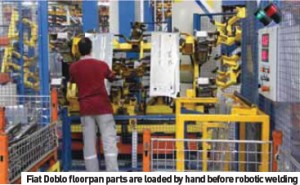
Honda also benefits from using manual labour in other production areas, as he goes on to explain. “In the paintshop, cars are sprayed manually. Since low volumes allow extended cycle times, our associates can deliver very good paint quality. The operator can see defects and solve the problem in the booth. Robots can’t see this and repairs must be made at a later stage. This is why our repair ratio is very low; our straight pass rate is 97%.” Sümer adds that it is only when operators cannot match the cycle time, currently 280 seconds, that automation must be considered. “Our maximum capacity is 100,000upa. If we reach that number, then we have to introduce robots onto the line.”
Local sales and export issues
Approximately 35% of Tofas production is destined for the Turkish market, with 65% being delivered to countries in and around the Eurozone. Very few models are sent to other markets, with a small number of CKD models delivered to Russia. There are no exports to the Middle East, the region receiving vehicles produced at Fiat’s European plants. Sinan Yildirim says that cars are shipped from the nearby port of Gemlik and also from Izmit, three hours from the plant. Parts from Europe are also received through the same ports. Trucks are used for local distribution, but he explains that the Turkish government is currently investigating the construction of a rail line to Bursa, which if linked to the plant, could greatly improve the movement of finished vehicles.
Like Tofas, Honda builds cars both for the local market and also specific countries and regions. Ísmail Sümer: “Cars produced here are sent to Russia, Israel, Poland, Scandinavia, Hungary and Ukraine. Last year we exported 50% of our production, compared to 2008, when we exported 70% of all vehicles. In terms of value, automotive is the number one export commodity of Turkey.”
Sümer goes on to say that vehicle content and specification changes by delivery region. “We block production for specific countries. One block is 30 units, all cars in the block have the same specification and go to the same region. Part delivery is done based on this blocking and each lineside delivery has enough parts for that block.” He says that it is up to material services to follow the production plan and deliver the correct parts for that block. “Our internal software offers total system transparency, so even on the delivery dock, they know what parts to unpack.”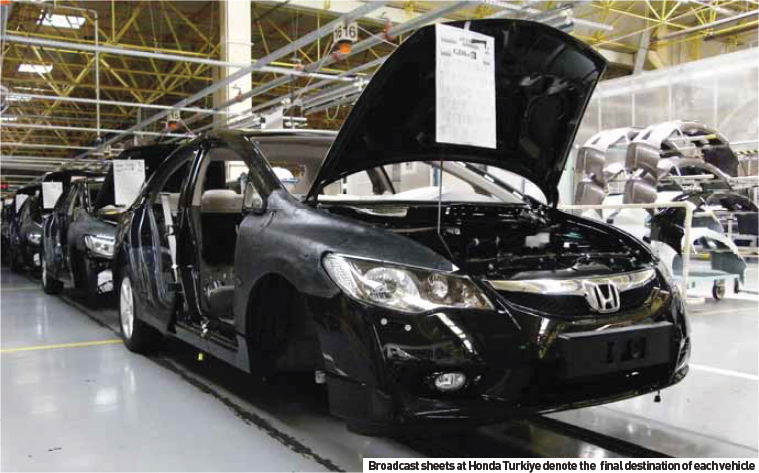
Working in Turkey
With the density of manual labour in Turkish car plants, it is a basic necessity to have a rich pool of potential candidates from which to draw. Tofas’s Akim Aydemír says that this is not a problem, as where they are located in Bursa is the historical centre of Turkish automotive production and the region has a strong manufacturing background. Another plus is the local concentration of suppliers and the number of qualified people. There are, though, other difficulties involved with local automotive production.
“Our problem is market fluctuation. Historically, the Turkish market is not as stable as Europe. The local market goes up and down due to the incentives that the government introduces. There is a lot of government intervention here.” These unexpected market fluctuations can cause problems with part procurement. When GM owned Fiat, Tofa


































